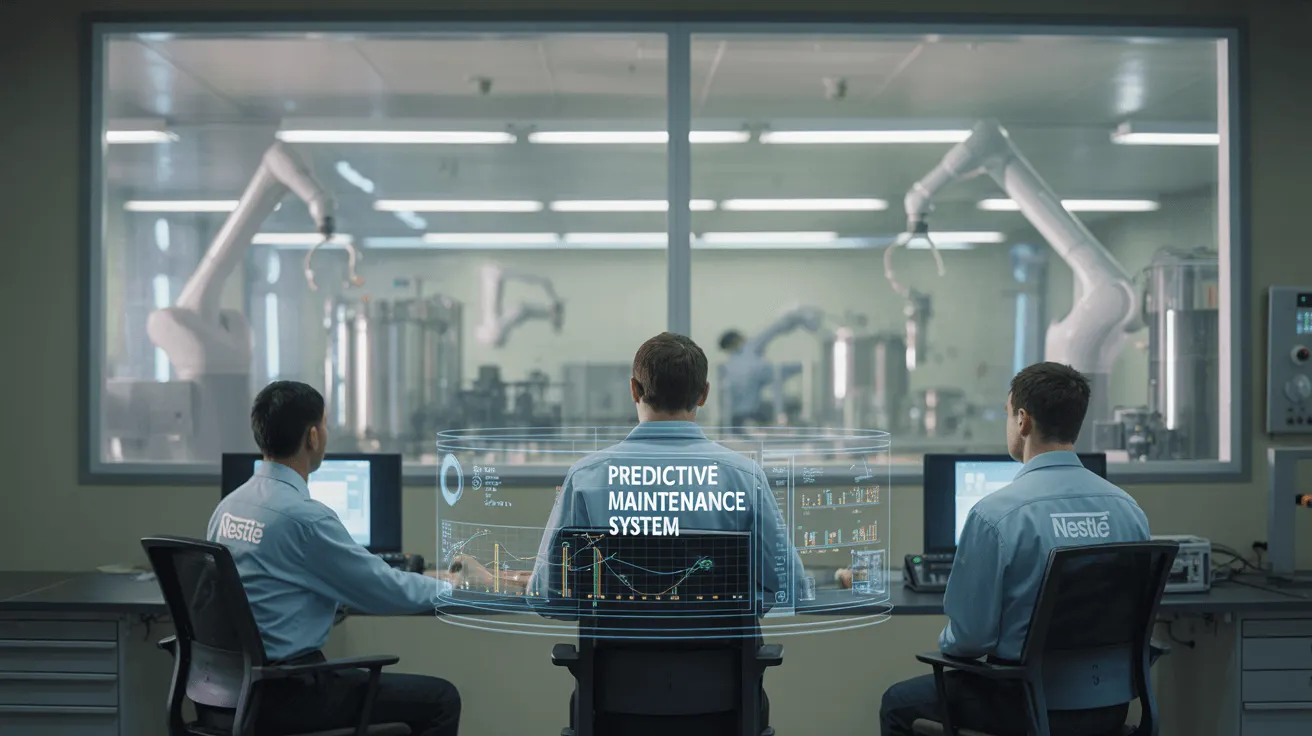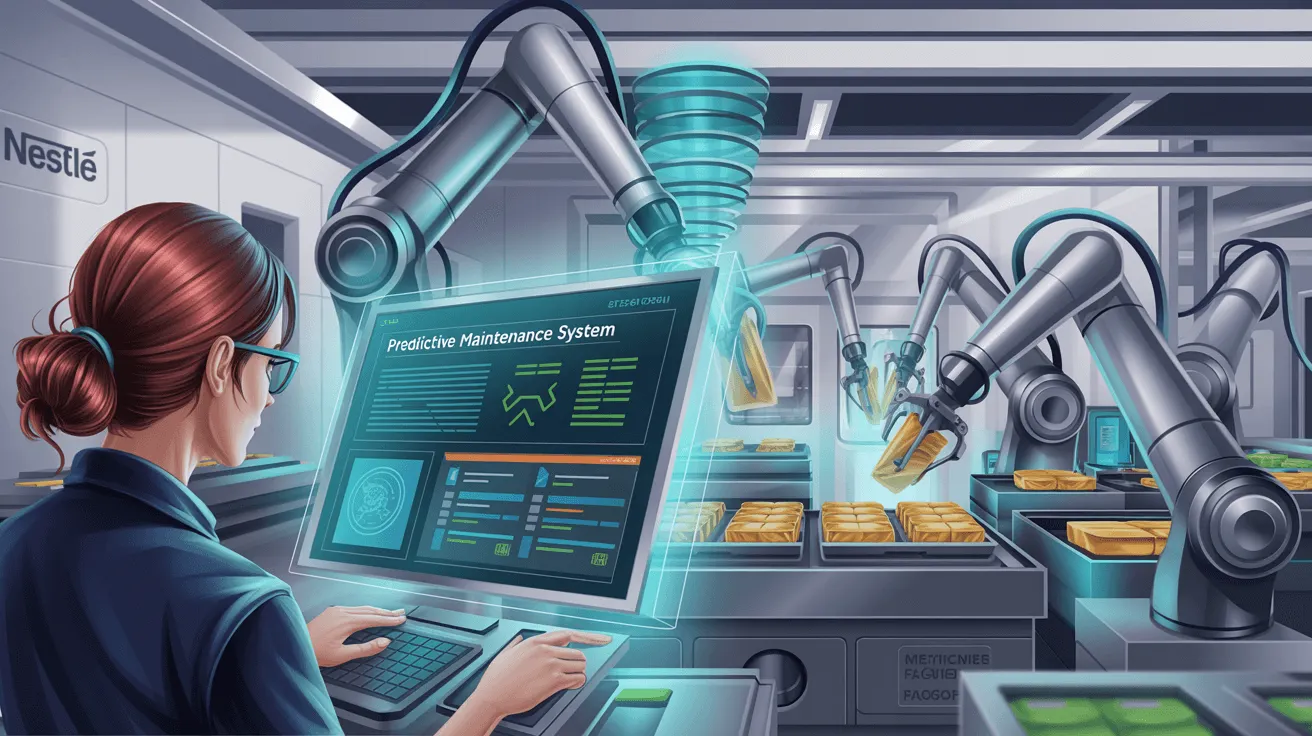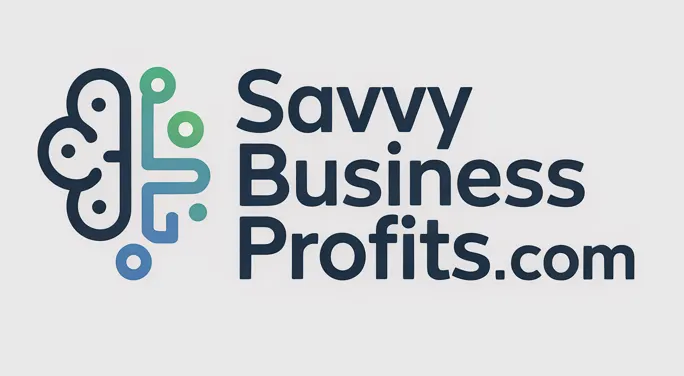Nestlé Cuts Downtime by 42% with AI: How Predictive Maintenance Transformed Global Factories.

Mark Peters, 20 · 5 minute read

Nestlé’s Predictive Maintenance Revolution: How AI Turned a $200 Million Problem into a Success Story (Lessons for SMBs)
Executive Summary
Imagine facing over $200 million in annual losses simply because machines break down unexpectedly. That was the reality for Nestlé, the world’s largest food and beverage company, before they decided to reimagine maintenance with artificial intelligence. Starting in 2020, Nestlé’s Cereal Partners Worldwide (CPW) division teamed up with AI specialist Seebo (later acquired by Augury) to launch a bold experiment: could AI predict and prevent costly equipment failures before they happened?
The answer was a resounding yes. By combining digital twins (virtual models of their production lines), powerful deep learning algorithms, and computer vision for quality control, Nestlé gained a real-time, 360-degree view of its manufacturing operations. This new approach didn’t just reduce headaches-it delivered a 42% cut in unplanned downtime, 38% lower maintenance costs, and $140 million in annual savings by 2025. Even better, it helped Nestlé hit its sustainability goals, cutting CO₂ emissions, water use, and waste.
This is a story packed with practical lessons for businesses of any size-including small and mid-sized manufacturers-looking to boost efficiency, reduce costs, and gain a competitive edge.
The Manufacturing Challenge: A Problem Every Business Faces
This is a story packed with practical lessons for businesses of any size-including small and mid-sized manufacturers-looking to boost efficiency, reduce costs, and gain a competitive edge.
Before 2020, Nestlé’s factories, like those of many manufacturers, were plagued by unexpected equipment failures. In the food and beverage industry, where products are perishable and quality standards are strict, a single breakdown could mean thousands of dollars lost every hour, wasted ingredients, and unhappy customers. For Nestlé, these disruptions added up to over $200 million per year.
And while that number is huge, the pain is universal. Even for small businesses, unplanned downtime can cripple production, delay orders, and eat into profits. One real-world example: a single power disruption at a Nestlé plant in Mexico cost $52,000 per hour. For smaller businesses, even a fraction of that loss can be devastating.
Nestlé’s struggles weren’t just about old machines-they also faced issues with new equipment not meeting promised performance, leading to lost production and wasted raw materials. These are the kinds of challenges that keep any business owner up at night.
The AI Toolkit: What Makes It Work
So how did Nestlé turn things around? The secret was a suite of AI technologies that any business can learn from:
Process-Based AI & Digital Twins: Seebo’s software created a digital twin-a virtual replica-of each production line, pulling in data from sensors and business systems. This let Nestlé see how every part of the process was connected, making it easier to spot inefficiencies and predict problems.osely watch your kids while you're at work
For small and mid-sized businesses, the key takeaway is that you don’t need to reinvent the wheel-many AI providers offer user-friendly tools that can be tailored to your needs and scaled as you grow.
A Step-by-Step Approach: How Nestlé Made It Happen
Nestlé’s journey wasn’t about rolling out technology everywhere at once. Instead, they started smart and scaled up:
1. Start with a Pilot: CPW, Nestlé’s cereal division, was the testing ground. With its complex processes and global reach, it was the perfect place to prove the concept.
2. Map the Process & Gather Data: Teams audited production lines, added sensors, and began collecting massive amounts of data-up to 2.4 terabytes daily. For smaller businesses, even basic data from critical machines can be a game-changer.
3. Build the AI Model: By combining deep learning with process-based AI and computer vision, Nestlé could rapidly identify the root cause of issues-87% of anomalies were flagged within 15 seconds.
4. Empower People with Insights: Maintenance teams received easy-to-understand alerts and recommendations, delivered through intuitive dashboards and even augmented reality tools. This made it simple for technicians to act quickly and confidently.
The lesson for SMBs: Start with a focused project, use data you already have, and choose technology that empowers your team rather than overwhelming them.

The Results: Numbers That Speak for Themselves
42% less unplanned downtime: Keeping production lines running and orders on track.
38% lower maintenance costs: Thanks to proactive repairs and less emergency overtime.
27% longer equipment lifespan: Machines lasted longer, saving on big-ticket replacements.
19% less energy use: Well-maintained machines run more efficiently.
33% less product waste: Fewer breakdowns meant less spoilage and higher quality.
$140 million in annual savings: With 68 factories using the system by 2025.
$94% accuracy in predicting bearing failures: Preventing costly shutdowns before they happened.
For SMBs, even a fraction of these improvements can mean the difference between struggling and thriving.
Beyond the Bottom Line: Sustainability and Strategic Value
Nestlé’s AI journey wasn’t just about saving money. It also became a key driver for sustainability, helping the company:
Cut CO₂ emissions by 23,000 tons per year
Reduce water use by 15%
Lower raw material waste by 9%
As Thierry Friant, Head of Continuous Improvement at Nestlé CPW, put it:
“Seebo’s Process-Based AI helped us rethink maintenance as a sustainability driver.” For businesses of any size, this is a powerful reminder that smart maintenance can boost your green credentials and appeal to eco-conscious customers.
Lessons for SMBs: How You Can Start Your Own AI Journey
Nestlé’s story is inspiring, but you don’t need to be a global giant to benefit. Here’s how any business can apply these lessons:
Identify your biggest pain points:
Where are equipment failures or inefficiencies costing you most?
Start small:
Pilot AI solutions on your most critical machines or lines.
Collect and use data:
Even simple sensors can provide valuable insights.
Empower your people:
Choose user-friendly tools and invest in training.
Measure results:
Set clear goals and track improvements.
Think beyond cost savings:
Use maintenance as a way to boost sustainability and brand reputation
Partner with experts:
Leverage technology vendors who understand your industry and scale.
The Road Ahead
Nestlé’s predictive maintenance success is just the beginning. As AI tools become more accessible, businesses of all sizes can harness their power to run smarter, more efficiently, and more sustainably. The key is to start with a clear goal, focus on practical solutions, and empower your people to make the most of the technology.
AI-driven maintenance isn’t just for the big players anymore-it’s a proven path to operational excellence for everyone.
Ready to Transform Your Business with AI?
Find out about our complete strategic framework that turns AI chaos into competitive advantage. The AI Transformation Playbook contains everything you need to implement AI successfully.
Click The Link Below To Learn More
© SavvyBusinessProfits 2025 All Rights Reserved
